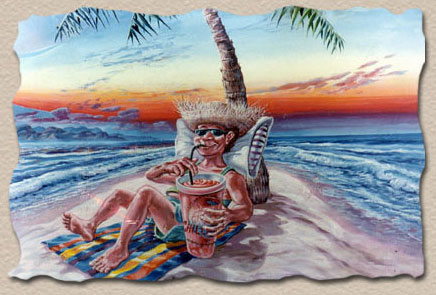
THE HISTORY OF MEXICO
Premium Mexico Links
Premium Mexico Links
* Discount Mexico Insurance by Mexbound * Discount Vacations by Mexico Travel Net
* Villa Rentals by Earth Sea Sky Vacations * Marina Costa Baja - Live the Dream Now!
The history of Mexico is extremely interesting. As one of the last major countries on earth to be established, it is remarkable that so much of the history of this country is so recent. Before the Revolucion of 1810 Mexico was just a large territory, and did not even have a constitution.
The culture of today's Mexico is also unique. Many different elements have converged on this special country to create a culture that is unique to the world. For more information visit the MEXICO CULTURE section of Mexico Expo.
A good book to read to gain more depth on Mexican history and culture is James Michner's "Mexico". This wonderful book takes the reader into the many facets of past and present day Mexico in a way that is very interesting every step of the way.
For additional information on the history and culture of Mexico drop by the Mexico Expo Market link on the left side of this page and check out some of the books on Mexico.
Mexico travelers interested in culture and archeology might want to visit the MEXICO WORLD HERITAGE SITES section of Mexico Expo.
For additional information on colonial buildings in the country visit the EXPLORING COLONIAL MEXICO web site.
More information on Mexico's colonial towns can be reviewed at MEXICO'S COLONIAL TOWNS.
Like the history of many countries, the history of Mexico pre-dates the country itself. The earliest signs of ancient civilizations in what is now Mexico date back thousands of years. After traveling from Asia to the North American continent via the land bridge at the Bering Straight approximately 12,000 years ago, tribes gradually inhabited North America and continued exploring south through Mexico and into present day Central and South America. An ancient town of significant size has been discovered northeast of Mexico City, and appears to have been populated around 5,000 BC These tribes had some highly developed skills, including farming, weaving, pottery making and even some degree of trade.
The Pre-Classic period saw expansion into other parts of Mexico around 1,500 BC, and Olmec Indian settlements became more common in much of this area called Mesoamerica between 800 through 400 BC
The Classic period in Mexico saw significant activity in Mexico history. Starting in about 200 BC and running through 500 AD the Teotihucan civilization had established a town of over 200,000 habitants and were becoming very civilized.
By the 7th century the Mayans had traveled north from present day Guatemala to settle in the Yucatan Peninsula region. During this same time period the Zapotecs were settling into the southern reaches of Mexico, and in 1325 the city of Tenochititlan was established where present day Mexico City is located. It was run by Moctezuma who was a wild and crazy guy.
The Post-classic period from 1,000 AD to 1,500 AD was a tumultuous time, well before the Spanish arrived (although the invention of pulque, tequila's predecessor, could have had something to do with it right around 1,000 AD). Different Indian factions fought to obtain new territories and for religious beliefs, and many local inhabitants were killed during these years.
The Spanish Conquest was one of the biggest factors to influence the native peoples of Mexico. During the late 15th century and early 16th century Spanish explorers repeatedly landed in the Gulf of Mexico and explored much of eastern and northern Mexico. In 1517 the Yucatan Peninsula was explored, and by 1518 much of the mainland had been mapped out. In 1519 a young (34 years old) Cortez left his new home in Cuba to conquer more of the country.
Although one of the main reasons Spain invaded the Mexican territory was to convert the local people to Christianity (the other reasons were to acquire new territories and accumulate wealth), after they were converted the Spanish used the local Indian population to their advantage. As slaves the Spanish forced them to work in farming, construction and in mining. Concurrently, over a 300 year period, over 10,000 churches were built throughout Mexico. And many of the Mexican towns still in use today are built on the central town square design with the adjacent church plan brought from Spain.
Over the years the influx of the Spanish blood mixed with the local Indians, and social classes were established that remain prevalent to this day. The existing population of Indians became the lower class of workers, descendants of mixed Indian and Spanish blood fell into a kind of middle social class, and the Creoles being direct descendents of Spanish parents, but actually born in Mexico, became the upper class. The elite class were the people living in Mexico that were actually born in Spain.
In 1810 a series of revolutions began to break Mexico free of Spanish rule. These battles lasted over 10 years until finally, on December 6th, 1822 the Mexican Republic was established. In 1823 a Constitution was approved and Mexico was on it's own.
Over the next 20 years over 30 individuals tried to take the helm of Mexico without any long term success. This internal weakness caused explorers from Spain, France and even the United States to try to take over various parts of the new Mexican country.
During this time the area of Texas was a Mexican territory, although the U.S. annexed the territory in 1845 (along with New Mexico and California). In 1847 U.S. troops fought hard to keep this new territory, and in 1848 the Treaty of Guadalupe Hidalgo was signed establishing the Rio Grande as the northernmost border for Mexico. The U.S. kept California, Arizona and New Mexico as part of the deal, and gave Mexico the Baja Peninsula as a gesture of compromise, along with $15,000,000. In all, over 1,300,000 square miles changed from Mexican territory to U.S. territory, approximately one third of Mexico's land. As much as the common citizen in the U.S. had no strong feelings about taking over this land from Mexico, it fell in with the U.S. government's westward expansion to control the land from 'sea to shining sea'.
The leadership in Mexico continued to change. Juarez was in control under democratic rule in 1872, but from 1876 through 1910 Porfido Diaz ran a dictatorship for 34 years. Although the economy expanded, the poor got poorer under this system of government and a long revoulcion began in 1910.
In 1929 the PARTIDO REVOLUCIONARIO INSTITUCIONAL (PRI) took control of Mexico and held the presidency through the balance of the century. The PRI holds political views with a somewhat socialistic slant, which many people claimed helped hold back the growth of the Mexican economy. In the year 2000 PARTIDO ACCION NACIONAL (PAN) took control under Vincent Fox. This political party tends to be more democratic in nature, and signs of an improving economy already seem to be on the way. It will probably take quite some time for the policies of the PAN party to take effect. Meanwhile, there tends to be a renewed sense of hope in the country as it works it's way into the new millennium.
TOP OF PAGE CANCUN EXPO CABO EXPO BAJA EXPO

